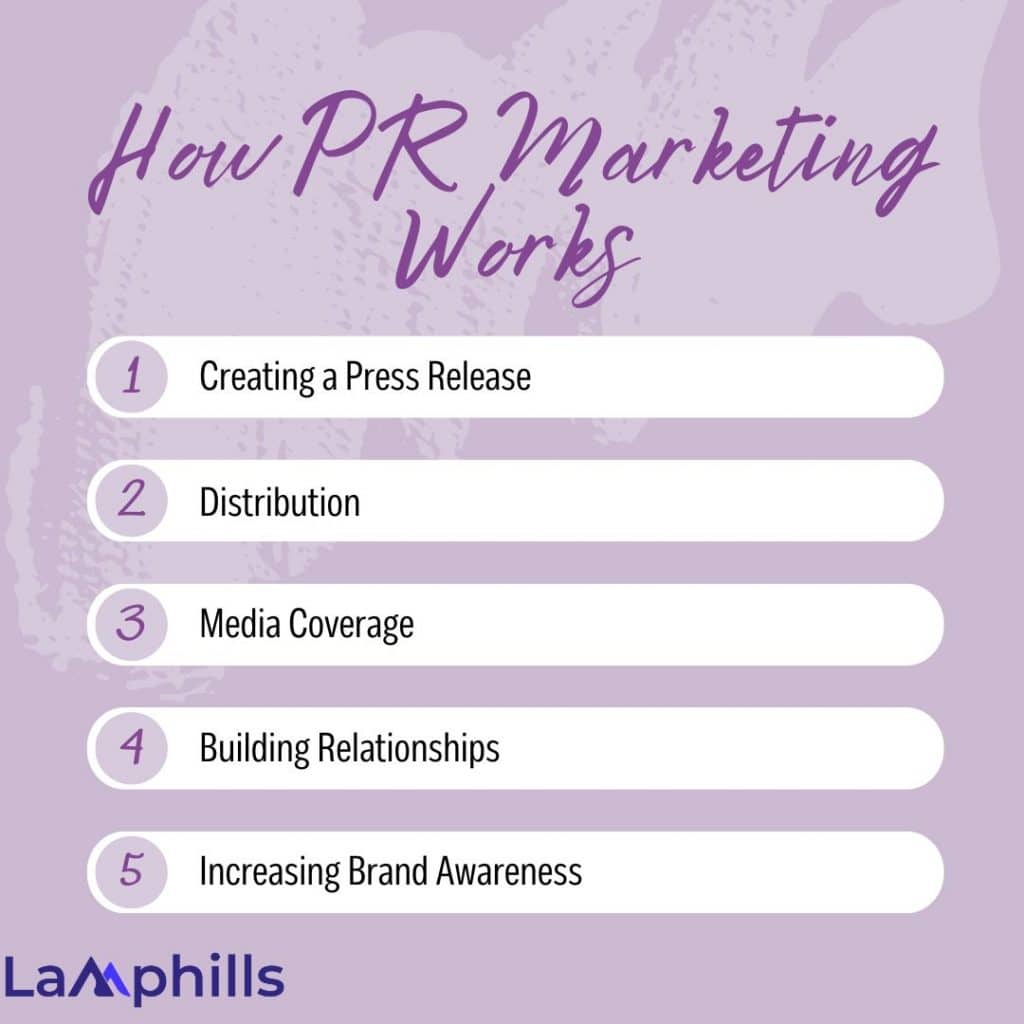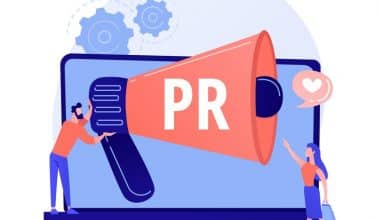Does your business have a PR strategy? What do you think is the effect of public relations in organisations and marketing? No matter how small or big your business is, a public relations strategy is essential to your success. While marketing focuses on promoting products and services, the true meaning of public relations lies in reputation management.
PR is often mistaken as a process that only takes place when something has gone wrong. But good media relations create public image, build awareness, and so much more. In the article below, I am going to talk about the role of PR marketing.
Key Points
- PR makes your brand trusted, shapes its image positively and helps it reach more people through media channels.
- PR helps to connect with more people through media channels, expanding brand visibility and influence.
- Brand image shaping is all about how people see your brand, so build a positive image.
What Is Public Relations in Marketing?
Public relations is a subset of marketing that focuses on building relationships with the public in order to create a positive public image for a company, organisation, or business. It is suitable for a new business to start getting some attention. It is also good if you have an existing business and want to get the word out.
One thing about this type of marketing is that it gets your name and business in front of more people than just customers and clients. It adds to your exposure in a tangible way, which most companies crave these days. The more direction you have, the more opportunities you will also have.
Public relations marketing is just the use of tactics and strategies to generate narratives, brand equity, beauty, and positive image highlights about your brand and untimely boost sales revenue. Public relations in marketing combines important business functions to create and share compelling stories, build relationships with your target audience and achieve your business goals.
How Does PR Marketing Work?
PR marketing involves developing strategies to increase awareness of your brand of business. It usually begins by creating a press release, which ends up being distributed via email to reporters and industrial influencers in your target markets. When reporters receive this release, they may decide to write an article about it that they will publish in their publication.

The first thing to do when you want to start a public relations campaign is to publicise your business. It’s better to start to beat a new product or service rather than those products with a lot of competitors, such as the clothing business or the food business. Another thing to consider is the media listing, which is just a list of all the publications in your area that might be interested in covering history. But before you start contacting these media outlets, be sure you research each one and make sure they’re relevant to what you are planning or promoting.
Read Also: Key Roles of Public Relations In Marketing
Let’s break this down using an example. So I have this friend of mine who opened a small cleaning product company. She wanted to build awareness, and credibility, and drive sales. So she decided to hire PR marketing personnel, Emma. Emma started by crafting a PR strategy that aligns with the company’s objectives. Emma then listed the media outlets, influencers, and prominent leaders in the cleaning company business. The next thing Emma did was announce Jamie Cleans’, my friend’s company, as a new product line, highlighting its unique eco-friendly features and benefits.
Emma then went ahead to release press news and secure publications with prominent sites such as The Daily News and The Punch. The next one was to start arranging interviews and secure speaking engagements at industry events and conferences to build credibility. So my friend on the other side was trying to make friends with social media influencers to generate buzz and drive sales.
Why Must You Consider Outsourcing PR for Your Business?
A lot of you might be stuck here, but its quite easy. With the rise of content marketing and blogging, PR is better than ever. Many companies choose to do their PR workhouse, and it’s an excellent option for some businesses. But some don’t have the time and expertise needed to manage it effectively, which is why outsourcing is a perfect option for many companies.
Here are some reasons why you must consider outsourcing your PR instead of handling everything in-house:
- It gives you the opportunity to hire professionals, which means that you can have a wide range of skills and experience. Not only will this ensure that your content is engaging, but it will also show how professionally I will prepare your business.
- Your business can save time by outsourcing the whole process. This means you don’t have to spend hours worrying about deadlines or results because you already have an expert who will handle your public relations.
- You get a lot of advantages for your business with experience in this area. Those who don’t have experience and time to dedicate to learning about how PR works often end up doing more harm than good for this business. To avoid this, you can invest in some help.
What Is the Role of Public Relations in Marketing?
In one way or another, every single organisation in the world relies on its reputation for success. PR is all about building and managing these reputations and as such, it’s always important to businesses.
#1. Increase Brand Credibility
Since PR is all about communicating information through an unbiased platform, you have to earn your space and hype. It automatically makes the brand information credible. Your business will be able to gain more credibility through public relations as the content is more authentic. When your company is featured in a reputable newspaper, it makes the company appear more trustworthy, and when the company or brand is granted an interview by an expert in that field, it helps to build the transparency and credibility of that brand.
By being in charge of your PR instead of just doing it for crisis management, you will generate lots of good press on a more proactive playing field. A proactive PR plan helps you to leverage opportunities, plan for emergencies, and calculate your steps in advance. Having your brand’s name and product communicated to the target audience
#2. Building Your Brand Image
Public relations is often misunderstood as all about promoting items or special offers. In reality, PR drives your business to greater success and constant growth. The brand image gets a boost when the target customers learn about it through a third-party media outlet. A good public relations strategy helps a brand build up its image in the way it wants to.
Without PR, your brand depends solely on its marketing efforts, such as social media and advertising. This may result in reaching a wide audience but it might not be enough and doesn’t resonate with credibility. When PR marketing is used, it builds credibility and trust with a wider audience. This leads to increased brand recognition, loyalty, and business growth.
#3. Reaching More People
It enables you to reach a pool of various people. A single press release can be sent to multiple newspapers, magazines, radio and television stations, blogs, and networks. Once the story is published, media outlets may pick it up, increasing how frequently it is read or heard.
Imagine what happens when a press release announces a new product launch. It increases a wider audience through media coverage. The press release will be picked up by a top-tier publication, reaching millions of readers and viewers all over the country.
#4. Increases Brand Sentiment
Do you have a new collection added to your brand and want to make people aware of it? PR strategy is the best strategy to go for. Your business is most likely doing some incredible things that are timely, relevant, and interesting. But without public relations to help busy journalists or editors, they might never get to hear about the new product. PR helps tell your story. Every company has a story, actions, and important information that customers need to know when making their decision about whether to buy your product versus competitors’ own.
With the realities of online reviews, content, and discussion websites, a business day faces disgruntled consumers, whether it is true or not. This is where a PR campaign can help to get sentiment back in the right direction, shed light on it, and reinforce brand values. Without PR, you allow that competitor to control the dialogue and define your reputation and who wants that?
#5. Connects to Coveted Audiences
Marketers and business owners can easily feel overwhelmed with so many options for PR. Getting access to these coveted audiences is a crucial component of your growth. PR strategy has the connection to reach audiences for both small and large businesses. Your business stands to become a routine source for the media and others to call on, quote, and provide further insight on each connection made. Getting access to these audiences is a crucial component of your growth.
Reaching your coveted audience simply means reaching your target audience. Let’s say you own an outdoor gear brand and you want to target hikers. Without PR, you might reach a wider audience but not necessarily or specifically your target audience and you won’t be able to bond with them. But when you decide to partner, maybe with a well-known hiking influencer. The person will share his or her posited review and experience with the audience through a sponsored post. It will effectively reach your target audience through a trusted and credible source.
What is the Public Relations Technique used in Marketing?
Public relations encompasses a variety of marketing tactics that all share a common focus, which is managing public perceptions. The most common PR techniques are listed below
#1. Media Relations
Media relations such as press releases, press interviews leading to news articles about any product, as well as press conferences. So the first time I heard about PR, the next thing that came to mind was public announcements about company news, talking to reporters and articles about new developments at a company.
PR plays an important role in identifying and building relationships with these individuals. The people responsible for PR are also involved in developing and distributing general information about an organisation. This information may consist of an annual report, a “state of the company” briefing call, video pieces about the company or its customers, and other publications that convey the company’s identity, vision, and goal.
#2. Sponsorships
Sponsorship is all about partnering with an organisation, events, or individuals. Take for example, a sportswear ambassador sponsoring a marathon, providing wear for participants and branding at the event, showcasing how comfortable their athletes are.
Sponsorship goes a long way with events, as organisations affliate themselves with events and organisations by signing on to co-sponsor something available to the community, like the example given above. Sponsorship can cover charitable events, athletes, sports teams, stadiums, trade shows, and conferences, as well as contests and lectures.
Marketing should select sponsorships carefully to make sure they are actually aligned with activities that are well-managed and strategically aligned with the public image that they are trying to create.
#3. Award Programme
Award programmes are another common PR technique. Your brand can participate in established advertising programmes managed by trade groups and media, and they can create award programmes that target their customer community. They can also help organisations identify great targets for case studies and public announcements to draw attention to how customers are benefiting from an organisation’s products and services.
Back then, in school, some of my classmates participated in faculty dinner awards and departmental dinner awards. It might sound like the organisation’s, but I would rather patronise and trust those with that award than those not recognised by the department or faculty Imagine when the marketing agency wins the industry award of the year. Such awards are given by the pulse; you will rather trust them because of their recognition.
#4. Crisis Management
What do you think the role of public relations is in this marketing issue? Let’s say, for example, that you own a food company and you face a product recall due to contamination. Your PR agency will swiftly swing in to render a public apology, recall actions, and state the corrective actions your company is taking to ensure it doesn’t repeat again. This minimises damage to your brand’s reputation.
It is an important PR toolkit to have on hand whenever it may be needed. Messaging, brand communication, listening, and relationship building all come to the fore. When handled effectively, these incidents may help an organisation recover from the crisis stronger and more resilient than it was before. This is the power of good PR.
Tips for an Effective PR Marketing Strategy
Creating a good PR campaign is vital for your company’s success. The tip below is what a PR agency uses to make its PR marketing a success.
#1. Make a Case
There should always be a reason why the media will cover your story. It can be your creativity or the uniqueness of your brand. Don’t just bombard them daily without any reason, because you won’t cover something if they don’t see its point. If you don’t have any specific reason, probably something that makes you different from your competitors, you will probably not get any publicity because it won’t drive any traffic to them.
#2. Aim Big
Aim high, but don’t aim too big. Set realistic goals and don’t expect them to happen all at once. Like my favourite quote, “If your dreams don’t scare you, then they’re not big enough,” that doesn’t mean you should set unattainable goals, especially without patience and effort. You might not get any coverage from major newspapers and magazines on the first day but keep trying for better publications over time and you will eventually start getting some coverage, even if it’s small at first.
#3. Build Relationships
What do you think is the golden rule in public relations marketing? Building a relationship is the golden rule and it’s not just about building relationships; it has to be genuine. If you are seeking a beneficial relationship with the reporter or influencer you are pitching to, you will have more success. Imagine when you build a very good and genuine relationship with a very popular influencer who deals with something relating to your brand. You guys can launch products together and collaborate on projects.
#4. Be Human
Before anything, we are humans. when reaching out to someone for the first time via email or phone. Be sure to mention personal details from your conversations; this makes you actually seem more genuine while also establishing common ground between the both of you. When communicating about your brand’s personality, be authentic. Share your values and story in such a way that it will create an emotional connection with your target audience.
Here is a more concise checklist to go with:
Public Relations in Marketing.pdf
What Are the Five Ps of PR?
PR focuses on how a brand is portrayed and promoted, constituting one of the traditional five Ps of marketing alongside produce, price, place, people, and promotion.
What Are The PR Tools?
These include oral communication, printed words, broadcast messages, and exhibitions. In other words, these are the different tools used for communication in public relations.
What Is the Key Principle of Public Relations?
Public relations efforts strive to maintain and build a positive image. They also inform your target audience about the positive associations with a product, service, brand, or organisation.
Conclusion
Coming to the end of this article, I want you to keep in mind that even though PR strategy is a very good marketing strategy for a business, do not forget that if anything goes wrong, it is going to have a significant effect, just as in good PR. So what is the best way to avoid this strategy when using public relations in marketing? Just carefully go through the tips again and follow them accordingly.
Related Article
- Key Roles of Public Relations In Marketing
- Public Relations Services: Trusted Public Relations Strategies for Success
- Advertising vs. Marketing: Which Should Your Business Focus On More?
- 11+ Public Relations Examples To Inspire Your Next Campaign
- PUBLIC RELATIONS SERVICES: The PR Blueprint for Getting Your Brand Noticed






